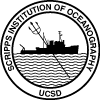
Ocean-Mixing
Experiment

|
Hawaii Ocean-Mixing Experiment | |||||
| HOME page | Historical Data | Modeling | Survey | Nearfield | Farfield | Scientist's Corner |
The HOME Farfield Experiment |
|
Baroclinic Tide RadiationA significant fraction of the energy lost from the barotropic tide is carried away from the Hawaiian Ridge by the radiation of low-mode internal tides. The exact amount of energy that might be carried by these waves is unknown at the moment; the estimates have varied considerably the past few years. Modeling provides one answer that appears to be quite accurate for the radiation in the nearfield. But it is an open question as to the amount of energy that entirely escapes the Hawaiian Ridge to be dissipated in the open ocean or on the opposite shores of the ocean basin. It may be that as the waves propagate from the Hawaiian Ridge they initially lose considerable energy in the first few wavelengths (few 100 km), before settling down to coherent waves. You can see transparencies from a talk presented at the AGU 2004 Ocean Sciences Meeting entitled "Radiation of Mode-1 Internal Tides from Topographic Features" HERE. You can also see the poster presented at the 2006 AGU Ocean Sciences Meeting, Honolulu, HI: "Radiation of Internal Tides from the Hawaiian Ridge: Implications for the Large-Scale Tidal Energy Budget", (2.5 MB PDF File).
The measurements consisted of line-averaging tomography indicated on the figure, together with thermistor's located on the tomography moorings. The combination of line-integral and point measurements provides a balance of spatial coverage and point measurements that best resolves the internal waves, given the limited resources [not meant to be a complaint about the resources, merely to state the obvious that, it is impossible to obtain all the data one would want]. The scale of the array is ideal for detecting the mode-1 waves that have 150-km wavelength. In addition, hydrographic casts were obtained from R/V FLIP for one month near the southern array, and the combination of these data and the thermistor data give an indication of the incoherent and high-mode content of the internal-tide radiation. |
 |
 |
 |
 |
|
| Email HOME Farfield Webmaster (Brian Dushaw) | ||||
|
This material is based upon work supported by the National Science Foundation under Grant No. 9819527. Any opinions, findings, and conclusions or recommendations expressed in this material are those of the authors and do not necessarily reflect the views of the National Science Foundation. |
||||